Cross Hands is a small town which sits across the route of the A48, twelve miles east of Carmarthen. The town was at one time part of the thriving Carmarthenshire coal field, which provided much of the work to the men in the area. The Cross Hands war memorial sits in a small garden of remembrance, and takes the form of a cross, which stands on a stone plinth. On the plinth are the names of the 16 local men who fell during the Great War, five men who died during the Second World War and another man who died during the Malayan Emergency. Many thanks to Mike Edwards for his photograph of the memorial.
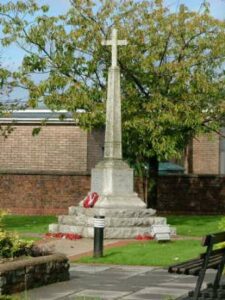
Cross Hands War Memorial, The Great War, 1914-1918
David Henry Daniels, Private, 74312, Welsh Regiment. David was born at Abergwili, the son of John and Margaret Daniels. The family later resided at Clynog House, Carmarthen Road, Cross Hands. David enlisted at Carmarthen on 25 April 1918 into the 4th Battalion, Welsh Regiment, which was a reserve battalion, and was posted to Pembroke Dock. David drowned while swimming at Golden Hill, Pembroke on 2 June 1918, aged only 19. He is buried at Cross Hands (Tabor) Baptist Chapelyard. David is not commemorated locally.
George Hudson, Lance Corporal, 2613, Welsh Regiment. George was born at Athlone, County Meath, and had served during the Boer War in South Africa. Prior to the Great War, he resided at Cross Hands, and re-enlisted at Cardiff into the 1st Battalion, Welsh Regiment. The Battalion were at Chakrata in India at the outbreak of war, and sailed from Karachi to Plymouth, landing on the 22nd December. They moved to Hursley Park in 84 Brigade, 28th Division, and on 18 January 1915 landed at Havre, and moved to the Western Front, where it saw its first major action during the Second Battle of Ypres. Following serious casualties at Ypres, a Composite Brigade was formed, composing of the 2nd Battalion, the Buffs, 2nd Battalion, the Cheshire’s, 1st Battalion, the Welsh, and 1st Battalion, the York and Lancaster. It was dissolved on 19 May 1915, and the formation assumed its normal configuration, taking part in the Battle of Loos. George was killed in action during the Battle of Loos, on 1 October 1915. He was 36 years old, and is remembered on the Loos Memorial, France.
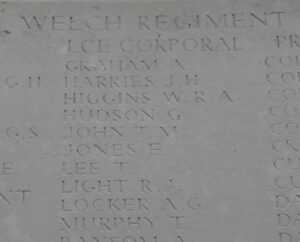
David James Jenkins, Private, 12877, Royal Welsh Fusiliers. David was the son of Thomas and Emily Mary Jenkins, of Rock Terrace, Cross Hands. He had enlisted at Tumble into the 9th Battalion, Royal Welsh Fusiliers. The battalion was attached to 58 Brigade, 19th (Western) Division, and moved to France between 11 and 21 July 1915, taking up trenches in the Givenchy sector. The Division fought a diversionary assault during the opening attack of the Battle of Loos. This is where David was killed in action, on 25 September 1915, aged only 18. He has no known grave, and so is remembered on the Loos Memorial, France. His brother William had died of wounds suffered at Gallipoli just a year previously. David is commemorated on the Cross Hands memorial while William is not.
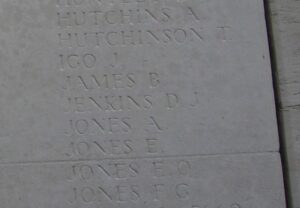
William Jenkins, Private, 13255, Royal Welsh Fusiliers. William was the son of Thomas and Emily Mary Jenkins, of Rock Terrace, Cross Hands. He lived at Capel Hendre prior to the war and enlisted at Ammanford into the 8th Battalion, Royal Welsh Fusiliers, which were attached to 40 Brigade, 13th (Western) Division. On 13 June 1915 the Division sailed for the Mediterranean, and in June 1915 the Divisional infantry landed on Cape Helles and relieved the 29th Division. They left and returned to Mudros at the end of the month, and the entire Division landed at ANZAC Cove from 3 August 1915, taking part in the Battle of Sari Bair. William was wounded here, and evacuated by Hospital Ship to Malta. He died of wounds aboard ship on 18 August 1915 aged 18 and is buried at Pieta Military Cemetery, Malta. His brother David James Jenkins was killed at Loos a year later. David is commemorated on the Cross Hands memorial while William is not.
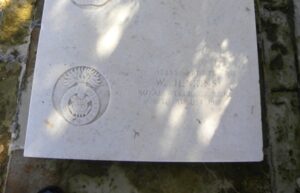
Evan Jones, Welsh Regiment. This man cannot be positively identified.
Gomer Jones, Private, 63138, Welsh Regiment. Gomer was the son of Rees and Alice Jones. His father died in 1905 and Alice married Morgan Daniels, of Furlong House, Cross Hands the following year. Gomer enlisted at Carmarthen into the army, and was posted to Salonika in 1917, joining the 11th Battalion, Welsh Regiment, who were attached to 67 Brigade, 22nd Division. Gomer was killed in action during the Second Battle of Doiran, on 18 September 1918, aged 30. He has no known grave, and so is remembered on the Doiran Memorial, Greece.
William Jones, Welsh Regiment. William cannot be positively identified.
Dan Mainwaring, Sapper, 48405, Royal Engineers. Dan was the son of Daniel and Hannah Mainwaring, of Glangwili Villa, Cross Hands. He enlisted in Tumble along with his twin brother William, joining the Royal Engineers, with consecutive service numbers. Both brothers landed in France on 16 July 1915, with the 93rd Field Company, Royal Engineers, which was attached to the 17th Northern Division. The Division were fighting around Ypres during December 1915, when Dan was badly wounded. He was to die of his wounds on 16 December 1915, aged 26, and was laid to rest at Bedford House Cemetery, Belgium.
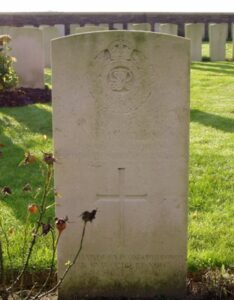
William Mainwaring, Sapper, 48406, Royal Engineers. William the son of Daniel and Hannah Mainwaring, of Glangwili Villa, Cross Hands. He enlisted in Tumble along with his twin Dan, into the Royal Engineers, with consecutive service numbers. Both brothers landed in France on 16 July 1915, with the 93rd Field Company, Royal Engineers, which was attached to the 17th Northern Division. Sometime after Dan’s death, William moved to the 237th Field Company, Royal Engineers, which formed part of the 40th (Bantam) Division. The Bantam Division was made of primarily of men who were originally too short to serve in the British Army, but after heavy losses in 1914/15, the minimum height limit was dropped. On 17 July 1918, the Division was holding the line near Ypres when William was mortally wounded. He was taken to the Military Hospital at Ljissenthoek, but died that day, aged 28. He lies in the massive Ljissenthoek Military Cemetery, Belgium.
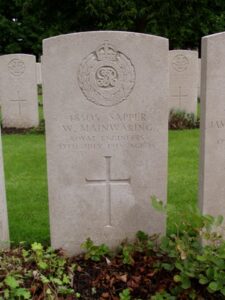
Ebenezer Thomas Morgan, Private, 47717, Labour Corps. Ebenezer was the son of David and Ann Morgan, of Plasnewydd, Cross Hands. He enlisted at Llanelli into the 21st Battalion, Welsh Regiment. The Battalion had formed at Colwyn Bay in July 1915 as a local reserve Battalion for the 38th (Welsh) Division, and from September 1915 was stationed at Kinmel. On 1 September 1916 they became the 61st Training Reserve Battalion at Kinmel in 13th Reserve Brigade. Ebenezer transferred at sometime to the Labour Corps. This was generally because someone was either not fit enough for front line duty, or that they had been wounded, and then deemed unfit to return. Ebenezer died in France on 17 November 1917, aged 39, and is buried at Rocquigny-Equancourt Road British Cemetery, Manancourt.
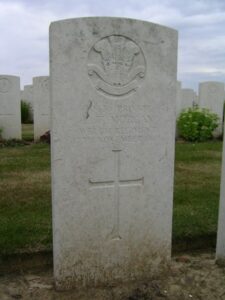
John Morgan, Private, 48946, Welsh Regiment. John was the son of Thomas and Hannah Morgan, of Tabor Villa, Cross Hands. He enlisted at Carmarthen into the army, and was posted to France in 1916, joining the 10th Battalion, Welsh Regiment, which was attached to 114 Brigade, 38th (Welsh) Division. The Division had landed in France during December 1915 and had spent their first winter in the trenches near Armentieres. In June they marched south to the Somme, where they were tasked with the capture of Mametz Wood. The attack began on 7 July, but met with fierce resistance, and it took days of fierce fighting to clear the wood.. The Division suffered terrible casualties at Mametz, and were taken out of the line, and moved to Ypres to rebuild. Here they fought at Pilckem Ridge and Langemarck. John was killed in action at Langemarck on 19 August 1917, aged 26. He has no known grave, and so is remembered on the Tyne Cot Memorial, Belgium.
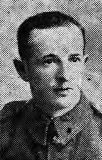
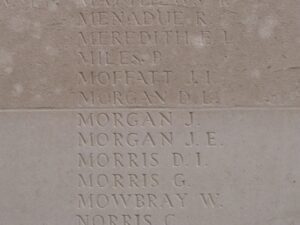
William John Morris, Private, 26938, Welsh Regiment. William was born in Pontypridd, and prior to the war lived at Cross Hands. He enlisted at Llanelli into the Welsh Regiment, and Landed in France on 21 April 1915, joining the 2nd Battalion, Welsh Regiment, who were attached to 3 Brigade, 1st Division. The Division had been one of the first to arrive in France, fighting at the Battle of Mons, and taking part in the retreat to the Marne, where the Germans were stopped. They then fought at the Aisne, and at Chivy, before being moved north to Ypres. Here they fought at the First Battle of Ypres, where they again stopped the German Offensive, before wintering in Flanders. The following year saw them in action again at the Battle of Aubers, before moving South to Loos. William was killed in action just a week before the opening of the Battle of Loos, on 17 September 1915. He is buried at Vermelles British Cemetery, France.
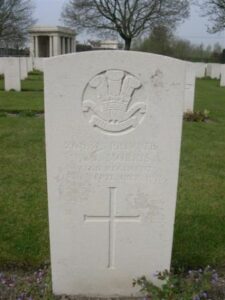
Daniel Quill, Private, 11913, South Wales Borderers. Daniel was born in Macroom, County Cork on 2 January 1879, the son of William and Ellen Quill. His family later emigrated and lived at Main Street, Pawtucket, Rhode Island, USA, while Daniel moved to Ivy Cottage, Cross Hands after gaining work as a colliery labourer. He was an army reservist and re-joined the 1st Battalion, South Wales Borderers at Brecon following the outbreak of war, before landing in France to join the battalion on 13 September 1914. He joined the battalion following its epic efforts during the retreat from Mons and the Battle of the Marne, in time to take part in the Battle of the Aisne, where the German drive on Paris was finally halted. On 11 October the battalion begun to entrain for northern France, heading for Ypres with 3 Brigade, 1st Division and by 21 October 1914 had taken up positions at Langemarck. During the march the battalion received orders to attack Poelcapelle. The day was one of terrible fighting. The war diary for the day states: ‘The Germans come on in great masses, silly idiots…’ Daniel was among 150 men killed in action during the days fighting. The 36-year-old has no known grave and is commemorated on the Ypres (Menin Gate) Memorial, Belgium. Daniel does not appear to be commemorated locally.
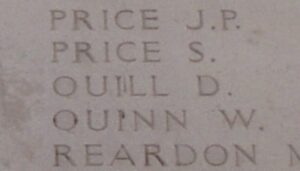
Thomas Stephen Ray, Private, 47582, Welsh Regiment. Thomas was born at Llanarthney in 1892, the son of John Steven and Annie Maria Ray. The family had lived at Bridgend for several years prior to Annie’s death, before returning to live at Bwlchgarw, Cefneithin. Thomas worked as a labourer prior to enlisting into the 2nd Battalion, Welsh Regiment at the outbreak of war. He served with the battalion in France from 13 September 1914, and would have taken part in the terrible fighting at the First and Second Battles of Ypres. He married Sarah Catherine Williams, of Nantyfyllon, while on leave in 1915 and rejoined the battalion in France. He was posted as a deserter on 26 August 1916 while the battalion was on the Somme, but must have been just missing, as he was then posted to the Training Reserve before continuing to serve with the 2nd Welsh for the remainder of the war. He died, probably of influenza, while still in France on 10 February 1919, aged 27, and is buried in Les Baraques Military Cemetery, Sangatte, France. Thomas does not appear to be commemorated anywhere locally.

Idris Tudor Rees, Private, 75290, Welsh Regiment. Idris was the son of Daniel George and Mary Ellen Rees, of Min-yr-Afon, Cross Hands. He enlisted at Cardiff on 23 May 1918 into the army, and on 14 September 1918 was posted to France, joining the 15th Battalion, Welsh Regiment, which was attached to 114 Brigade, 38th (Welsh) Division. The Division had been in France since December 1915 and had fought at Mametz Wood and Pilckem Ridge. Idris joined the battalion during the course of the advance to victory, after it had advanced across the Somme battlefields towards the Hindenburg Line. The Division then fought at the Battle of Beaurevoir, and moved up towards Cambrai, capturing Villers-Outreaux. Idris was wounded during this great advance, and died of wounds on 9 October 1918, aged 19. He is buried at Beaulencourt British Cemetery, Ligny-Thilloy, France.
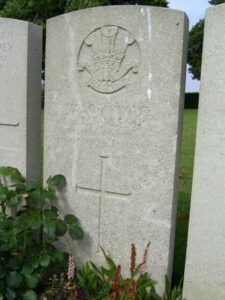
Thomas Rees, Gunner, 215603, Royal Garrison Artillery. Thomas was the son of Meredith and Jane Rees, of Nantymelin, Staylittle, Llanbrynmair, Montgomeryshire. He resided at Pantyddauddwr, Cross Hands prior to the war, working as a collier, and enlisted at Llanelli on 23 February 1916 into the Royal Garrison Artillery. Thomas was posted to France on 3 May 1918 and joined the 503rd Siege Battery, Royal Garrison Artillery, which was attached to the Third Army. During August 1918 the Third Army were on the Somme, where the Allies were planning to launch their great offensive, which ultimately led to the winning of the war. On 22 August 1918 Thomas had gone for a walk to an orchard at Bienvillers, and was filling his hat with apples to bring back to his gun crew when he was killed by a grenade explosion. Fellow crew members ran to his aid after hearing the explosion, only to find Thomas lying dead, with his cap in his hand. A subsequent court of enquiry ruled out suicide, and ruled his death as being accidental. Whether or not he was using grenades to attempt to blow apples from the tree is a mystery. Thomas was 23 years old when he was killed that day, and is buried at Bienvillers Military Cemetery, France.
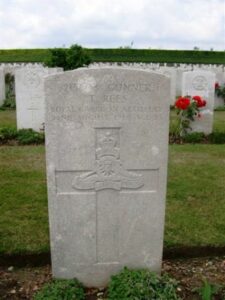
Thomas Abraham Richards, Ordinary Seaman, J/76476, Royal Navy. Thomas was born at Gorseinon on 4 November 1898, the son of John and Lizzie Jane Richards. The family later moved back to his father’s family home at Myrddin House, Cross Hands. Thomas served in the Royal Navy, aboard H.M.S. Narborough, which was an ‘M’ Class Destroyer. On 12 January 1918 Narborough had joined her sister ship Opal to hunt for German Destroyers. In heavy seas and a thick snowstorm, both destroyers ran aground off the Orkneys, and sank with huge loss of life. Thomas was lost that day aboard the Narborough, aged only 19. He is remembered on the Plymouth Naval Memorial, Devon. Thomas is not commemorated at Cross Hands.
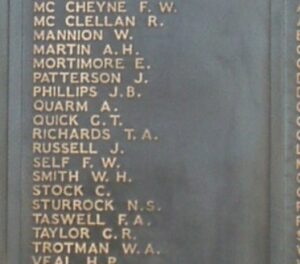
Francis Roderick B.A, Lieutenant, Welsh Regiment. Francis was the son of David and Elizabeth Roderick, of Cwmcerig Fach, Cefneithin. He was educated at Aberystwyth University before enlisting into the 16th Battalion, Royal Welsh Fusiliers at the outbreak of war. On 9 January 1915 Francis was commissioned into the 14th Battalion, Welsh Regiment, which was at Rhyl. In December 1915 the battalion moved to France, attached to 114 Brigade, 38th Welsh Division. Francis survived the Battalions massacre on the Somme, where the entire Welsh Division suffered terrible casualties at Mametz Wood, and moved with his battalion to Ypres. After almost twelve months holding the Boesinghe sector, on 31 July 1917 the 38th Division began its famous attack on Pilckem Ridge. Francis was mortally wounded during the assault, and died that same day, aged 22. He is buried in Bard Cottage Cemetery, Belgium.

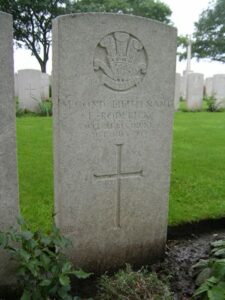
Dan Thomas, Private, 203471, Welsh Regiment. Dan was born at Eglwysfair-Y-Churig around 1884, the son of James and Hannah Thomas, Tailor and Draper, of Parky Llain Isha, Eglwysfair. He resided at Penybryn, Cross Hands prior to the war, with his wife Gwenllian Thomas, and he worked as a Stoker at the Cross Hands Colliery. Dan enlisted at Llanelli into the 11th Battalion, Welsh Regiment, which was attached to 87 Brigade, 22nd Division. The Division crossed to France in early September 1915, with all units being concentrated near Flesselles by 9 September, but after just two months in the trenches, were sent to Salonika, completing concentration there in November 1915. The Division then remained in the Salonika theatre, where it fought a wretched campaign against the Bulgarians. Dan was killed in action during the Second Battle of Doiran on 18 September 1918. He was 35 years old. Dan has been forgotten for almost 94 years, but after forwarding evidence about him to the CWGC in January 2012, Dan has recently, Tuesday 22 March 2012, been accepted for commemoration by the CWGC, who will be adding his name to the Addenda Panel of the Doiran Memorial, Greece. The reason for Dan being forgotten is relatively simple, as on the same day another Private D. Thomas in the same Battalion was killed. This man was Private David Thomas, of Bangor, North Wales, and his number was 203441, very similar to Dan’s.
Gwilym Thomas, Private, 12910, Welsh Regiment. Gwilym was the son of John and Mary Ann Thomas, of Hebron House, Cross Hands. He enlisted at Tumble into the Welsh Regiment and landed in France on 16 March 1915, joining the 1st Battalion, Welsh Regiment, which was attached to 84 Brigade, 28th Division. The Division formed in England between December 1914 and January 1915 from regular units returning from India, Singapore and Egypt. During January 1915 it moved to France, landing at Le Havre and moved to the Western Front, where it saw its first major action during the Second Battle of Ypres. Following serious casualties at Ypres, a Composite Brigade was formed, composing of the 2nd Battalion, the Buffs, 2nd Battalion, the Cheshire’s, 1st Battalion, the Welsh, and 1st Battalion, the York and Lancaster. It was dissolved on 19 May 1915, and the formation assumed its normal configuration, taking part in the Battle of Loos. Gwilym was wounded at Loos, and died of wounds on 12 October 1915 aged only 17. Gwilym is buried at Les Gonards Cemetery, Versailles, France. By the time of his death, the Division were moving to Marseilles to embark for service in Salonika. Gwilym must have died on the journey south with the Division.
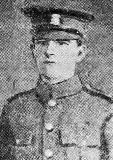
John Calandydd Thomas, Private, 201358, Welsh Regiment. John resided at cross Hands, and served with the 1/4th Battalion, Welsh Regiment, which was attached to 159 Brigade, 53rd (Welsh) Division. The Division moved to the Mediterranean, sailing from Devonport in July, 1915 arriving at Mudros by 5 August 1915. From here they moved to Gallipoli, landing on 9 August. Here they immediately faced the chaotic leadership that was to lead to the ultimate failure of the campaign, and spent the next few days in isolated pockets, fighting against a Turkish counter-attack. The Division remained here throughout the coming months, and suffered severe losses in manpower strength during the great November 1915 blizzard on Gallipoli, when its total strength was reduced to less than that of a full-strength Brigade. On 11 December 1915 the Division was evacuated to Mudros, and by 23 December 1915 were moved to Egypt. They remained on the Suez Canal Defences for the next twelve months, and in early 1917 moved into Palestine, where they remained for the duration of the war, fighting at the Battles of Gaza, and successfully capturing Jerusalem. John was wounded during the Battle of Jerusalem, and died there just days later, on 13 December 1917. He is buried at Jerusalem War Cemetery, Israel.
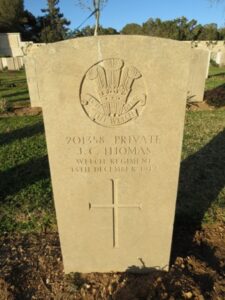
World War Two, 1939-1945
Thomas Raymond Crowther, Sergeant (Air Gunner), 1414489, Royal Air Force Volunteer Reserve. Thomas was the Son of Francis Edwin and Florence Eliza Crowther, of Cross Hands, and served with 57 Squadron, RAFVR who flew the Avro Lancaster I, based at RAF Scampton. On the night of 28 August 1943, Thomas’ Lancaster was shot down over Germany while returning from a bombing run over Nuremberg, and the entire crew were killed. Thomas was just 20 years old, and is buried at Durnbach War Cemetery, Germany.
David Verdun Evans, Civilian, Civilian War Dead. David was the Son of D. G. and Amelia Evans, of Terminus, Cross Hands. He worked at the Royal Ordnance Factory in Pembrey. The factory was built by Nobel’s Explosives, and manufactured TNT for the Ministry of Supply. On 10 July 1940 the factory became a target for the Luftwaffe, and was heavily bombed that day, causing many casualties. David was one of many people rushed to Llanelli Hospital, but he sadly died that same day. He was 22 years old, and is buried at Llanelli Borough Cemetery.
Ronald Jones, Stoker 1st Class, P/KX 97340, Royal Navy. Ronald was the Son of John and Mary L. Jones, of Cross Hands, and served in the Royal Navy aboard H.M.S. Latona. She was a minelayer, and was operating off the coast of Tobruk in the Mediterranean, when she was attacked and sunk by German Stuka Dive-Bombers on 25 October 1941. Ronald was killed aboard the ship that day, aged 26, and is remembered on the Portsmouth Naval Memorial, Hampshire.
Thomas Emrys Rees, Sergeant, 1277699, Royal Air Force Volunteer Reserve. Thomas was the Son of Elizer and Elizabeth Ann Rees, of Cross Hands, and served with 156 Squadron, RAFVR, which flew the Avro Lancaster I, based at RAF Warboys. 156 Squadron were a Pathfinder Squadron, made up of the cream of the crews of RAF Bomber Command. On the night of 23 December 1943 Thomas and his crew took off for a mission in their Aircraft JB711, to mark targets over Abbeville and Amiens. They were shot down on their return journey the following morning, and crashed in the Channel. Thomas was just 20 years old, and is remembered on the Runnymede Memorial, Surrey. He had flown 14 sorties since becoming qualified.
Post World War 2
Vernon Bowen, Sergeant (Navigator), 1654380, Royal Air Force. Vernon was born at Cross Hands on 20 September 1923. Details of his service are not known, as the World War 2 service records are as yet unobtainable, but Vernon was serving at Singapore, based at RAF Tengah, as a Navigator with 45 Squadron, Royal Air Force during the Malayan Emergency. The Malayan Emergency was a guerrilla war for independence fought between Commonwealth armed forces and the Malayan National Liberation Army, the military arm of the Malayan Communist Party, from 1948 to 1960. The Royal Air Force flew Avro Lincolns and Bristol Brigands from Singapore on bombing raids over Communist Malaya. Vernon was Navigator of a three man crew of a Bristol Brigand, consisting of Pilot Alan Martin and Radio Operator Peter Weston. On the morning of 15 June 1951, the crew were asked to do an air test on their Brigand VS857 (OB-K), and took off from Tengah just before lunch. The aircraft was headed north and climbing when what seemed like a massive explosion rocked the aircraft, and sent it out of control over Changi Creek, where it crashed moments later. Alan Martin and Peter Weston had survived, but sadly Vernon had been killed in the crash, his body being found underneath the wreckage of the fuselage. A later investigation found that a propeller had broken loose- a common problem on Brigands, and it was that which had made the aircraft lose control. Vernon was 27 years old when he died that day, and his body was interred at Kranji Military Cemetery.